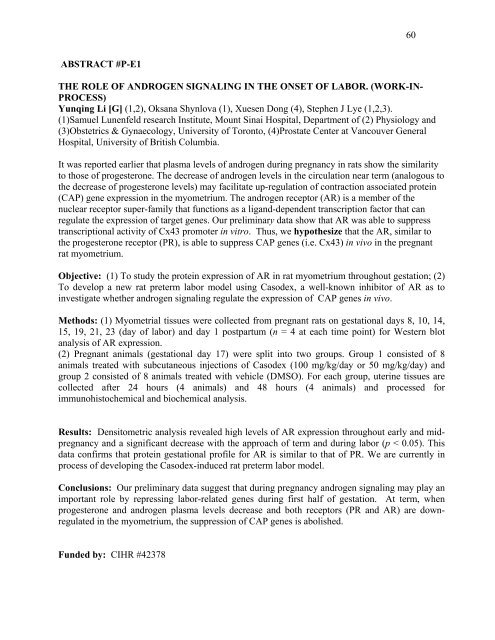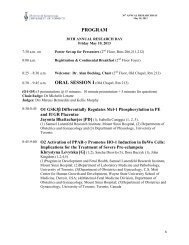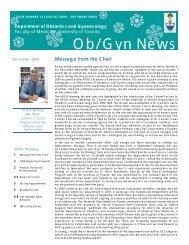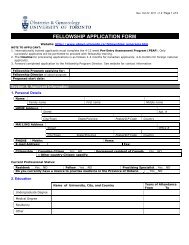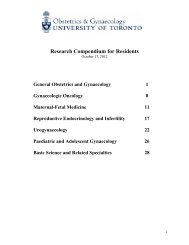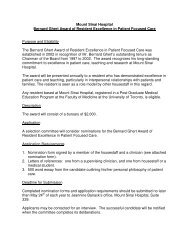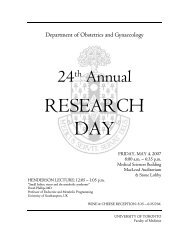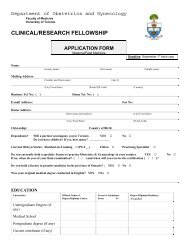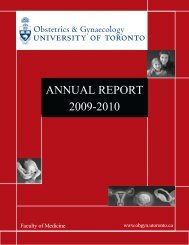research day - University of Toronto Department of Obstetrics and ...
research day - University of Toronto Department of Obstetrics and ...
research day - University of Toronto Department of Obstetrics and ...
You also want an ePaper? Increase the reach of your titles
YUMPU automatically turns print PDFs into web optimized ePapers that Google loves.
60<br />
ABSTRACT #P-E1<br />
THE ROLE OF ANDROGEN SIGNALING IN THE ONSET OF LABOR. (WORK-IN-<br />
PROCESS)<br />
Yunqing Li [G] (1,2), Oksana Shynlova (1), Xuesen Dong (4), Stephen J Lye (1,2,3).<br />
(1)Samuel Lunenfeld <strong>research</strong> Institute, Mount Sinai Hospital, <strong>Department</strong> <strong>of</strong> (2) Physiology <strong>and</strong><br />
(3)<strong>Obstetrics</strong> & Gynaecology, <strong>University</strong> <strong>of</strong> <strong>Toronto</strong>, (4)Prostate Center at Vancouver General<br />
Hospital, <strong>University</strong> <strong>of</strong> British Columbia.<br />
It was reported earlier that plasma levels <strong>of</strong> <strong>and</strong>rogen during pregnancy in rats show the similarity<br />
to those <strong>of</strong> progesterone. The decrease <strong>of</strong> <strong>and</strong>rogen levels in the circulation near term (analogous to<br />
the decrease <strong>of</strong> progesterone levels) may facilitate up-regulation <strong>of</strong> contraction associated protein<br />
(CAP) gene expression in the myometrium. The <strong>and</strong>rogen receptor (AR) is a member <strong>of</strong> the<br />
nuclear receptor super-family that functions as a lig<strong>and</strong>-dependent transcription factor that can<br />
regulate the expression <strong>of</strong> target genes. Our preliminary data show that AR was able to suppress<br />
transcriptional activity <strong>of</strong> Cx43 promoter in vitro. Thus, we hypothesize that the AR, similar to<br />
the progesterone receptor (PR), is able to suppress CAP genes (i.e. Cx43) in vivo in the pregnant<br />
rat myometrium.<br />
Objective: (1) To study the protein expression <strong>of</strong> AR in rat myometrium throughout gestation; (2)<br />
To develop a new rat preterm labor model using Casodex, a well-known inhibitor <strong>of</strong> AR as to<br />
investigate whether <strong>and</strong>rogen signaling regulate the expression <strong>of</strong> CAP genes in vivo.<br />
Methods: (1) Myometrial tissues were collected from pregnant rats on gestational <strong>day</strong>s 8, 10, 14,<br />
15, 19, 21, 23 (<strong>day</strong> <strong>of</strong> labor) <strong>and</strong> <strong>day</strong> 1 postpartum (n = 4 at each time point) for Western blot<br />
analysis <strong>of</strong> AR expression.<br />
(2) Pregnant animals (gestational <strong>day</strong> 17) were split into two groups. Group 1 consisted <strong>of</strong> 8<br />
animals treated with subcutaneous injections <strong>of</strong> Casodex (100 mg/kg/<strong>day</strong> or 50 mg/kg/<strong>day</strong>) <strong>and</strong><br />
group 2 consisted <strong>of</strong> 8 animals treated with vehicle (DMSO). For each group, uterine tissues are<br />
collected after 24 hours (4 animals) <strong>and</strong> 48 hours (4 animals) <strong>and</strong> processed for<br />
immunohistochemical <strong>and</strong> biochemical analysis.<br />
Results: Densitometric analysis revealed high levels <strong>of</strong> AR expression throughout early <strong>and</strong> midpregnancy<br />
<strong>and</strong> a significant decrease with the approach <strong>of</strong> term <strong>and</strong> during labor (p < 0.05). This<br />
data confirms that protein gestational pr<strong>of</strong>ile for AR is similar to that <strong>of</strong> PR. We are currently in<br />
process <strong>of</strong> developing the Casodex-induced rat preterm labor model.<br />
Conclusions: Our preliminary data suggest that during pregnancy <strong>and</strong>rogen signaling may play an<br />
important role by repressing labor-related genes during first half <strong>of</strong> gestation. At term, when<br />
progesterone <strong>and</strong> <strong>and</strong>rogen plasma levels decrease <strong>and</strong> both receptors (PR <strong>and</strong> AR) are downregulated<br />
in the myometrium, the suppression <strong>of</strong> CAP genes is abolished.<br />
Funded by: CIHR #42378


